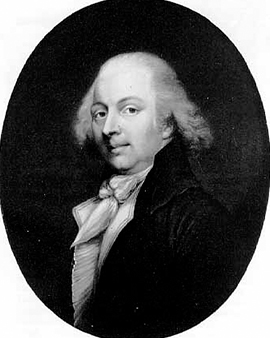On the one hand, the 18th century was the time of colonialism, during which expeditions to the South Seas took place that are still shrouded in legend today. Since, of course, there was no photography at that time, painters played a central role in these adventurous expeditions, alongside sailors. In this historical context the English painter and draughtsman with Swiss roots John Webber, born Johann Wäber, became famous and appreciated.
Webber first worked as an apprentice at Johann Ludwig Aberli, a landscape painter from Bern. He then studied at the Académie Royale in Paris with Johann Georg Wille. Webber was able to finance his studies with the help of a scholarship awarded to him by the "Gesellschaft zu Kaufleuten". He then returned to London and, driven by a thirst for knowledge, studied at the Royal Academy of Arts.
The Swedish botanist Daniel Carl Solander recognized Webber's talent in exhibited nature and landscape paintings and engaged him as an expedition painter for the famous third expedition in the South Seas of Captain James Cook. This made John Webber the very first Swiss to visit Australia, more precisely Bruny Island off Tasmania. However, John Webber did not see himself as a simple expedition painter. He saw himself much more as a travel journalist for an audience that was increasingly interested in travel reports of this kind. The expedition, which was initially scheduled to last only three years, was delayed by the death of James Cook and due to difficulties in the North Pacific during the return journey.
In 1793 John Webber died of kidney failure. In the last years of his life, Webber undertook extensive study trips to the north of England, France and Bern in Switzerland, where he spent his childhood.
×





.jpg)
.jpg)
_-_(MeisterDrucke-1030688).jpg)
_-_(MeisterDrucke-1030688).jpg)
.jpg)
.jpg)
.jpg)
.jpg)
.jpg)
.jpg)
_-_(MeisterDrucke-36047).jpg)
_-_(MeisterDrucke-36047).jpg)
_tue_par_les_indigene_-_(MeisterDrucke-1031331).jpg)
_tue_par_les_indigene_-_(MeisterDrucke-1031331).jpg)
 being received by Queen Ob - (MeisterDrucke-265739).jpg)
 being received by Queen Ob - (MeisterDrucke-265739).jpg)
.jpg)
.jpg)
.jpg)
.jpg)
.jpg)
.jpg)
.jpg)
.jpg)
.jpg)
.jpg)
.jpg)
.jpg)
.jpg)
.jpg)
.jpg)
.jpg)
_-_(MeisterDrucke-994500).jpg)
_-_(MeisterDrucke-994500).jpg)
.jpg)
.jpg)
.jpg)
.jpg)
.jpg)
.jpg)
.jpg)
.jpg)
.jpg)
.jpg)
_China_Seas_-_(MeisterDrucke-1434895).jpg)
_China_Seas_-_(MeisterDrucke-1434895).jpg)
.jpg)
.jpg)
.jpg)
.jpg)
.jpg)
.jpg)
.jpg)
.jpg)
.jpg)
.jpg)
.jpg)
.jpg)
.jpg)
.jpg)
.jpg)
.jpg)
.jpg)
.jpg)
.jpg)
.jpg)
.jpg)
.jpg)
.jpg)
.jpg)
.jpg)
.jpg)
.jpg)
.jpg)
_made_du_-_(MeisterDrucke-1100864).jpg)
_made_du_-_(MeisterDrucke-1100864).jpg)
.jpg)
.jpg)
_-_(MeisterDrucke-1030687).jpg)
_-_(MeisterDrucke-1030687).jpg)
.jpg)
.jpg)
.jpg)
.jpg)
.jpg)
.jpg)
.jpg)
.jpg)
.jpg)
.jpg)
.jpg)
.jpg)
.jpg)
.jpg)
_c1784_(oil_on_canvas)_-_(MeisterDrucke-1502417).jpg)
_c1784_(oil_on_canvas)_-_(MeisterDrucke-1502417).jpg)
.jpg)
.jpg)
.jpg)
.jpg)
.jpg)
.jpg)
.jpg)
.jpg)
.jpg)
.jpg)
.jpg)
.jpg)
.jpg)
.jpg)
.jpg)
.jpg)
.jpg)
.jpg)
_-_(MeisterDrucke-636800).jpg)
_-_(MeisterDrucke-636800).jpg)
.jpg)
.jpg)
.jpg)
.jpg)
.jpg)
.jpg)
.jpg)
.jpg)
.jpg)
.jpg)
.jpg)
.jpg)
.jpg)
.jpg)
.jpg)
.jpg)
.jpg)
.jpg)
.jpg)
.jpg)
.jpg)
.jpg)
.jpg)
.jpg)
_(China)_Oil_on_canvas_-_(MeisterDrucke-1498639).jpg)
_(China)_Oil_on_canvas_-_(MeisterDrucke-1498639).jpg)
.jpg)
.jpg)
.jpg)
.jpg)
.jpg)
.jpg)
_-_(MeisterDrucke-1030680).jpg)
_-_(MeisterDrucke-1030680).jpg)
.jpg)
.jpg)
_-_(MeisterDrucke-1015800).jpg)
_-_(MeisterDrucke-1015800).jpg)
.jpg)
.jpg)
_-_(MeisterDrucke-977274).jpg)
_-_(MeisterDrucke-977274).jpg)
.jpg)
.jpg)
.jpg)
.jpg)
.jpg)
.jpg)
.jpg)
.jpg)
.jpg)
.jpg)
.jpg)
.jpg)
.jpg)
.jpg)
_-_(MeisterDrucke-994501).jpg)
_-_(MeisterDrucke-994501).jpg)
.jpg)
.jpg)
_Daughter_of_Oreo_Chief_of_Ulaietea_One_of_the_Society_Isles_-_(MeisterDrucke-897851).jpg)
_Daughter_of_Oreo_Chief_of_Ulaietea_One_of_the_Society_Isles_-_(MeisterDrucke-897851).jpg)
.jpg)
.jpg)
.jpg)
.jpg)
.jpg)
.jpg)
.jpg)
.jpg)
.jpg)
.jpg)
.jpg)
.jpg)
_-_(MeisterDrucke-1015797).jpg)
_-_(MeisterDrucke-1015797).jpg)
.jpg)
.jpg)
.jpg)
.jpg)
.jpg)
.jpg)
.jpg)
.jpg)






